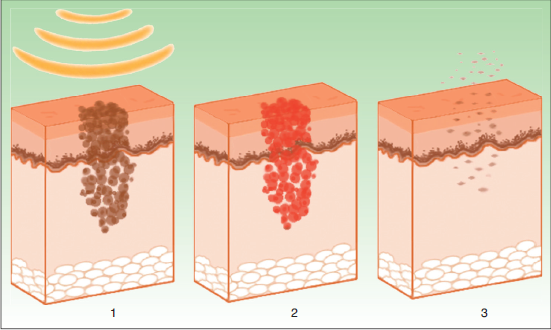IPL Intense Pulsed Light.
IPL stands for Intense Pulsed Light.
Intense pulsed light (IPL) involves the emission of a non-coherent, non-collimated, polychromatic light energy that covers various wavelengths (between 400 and 1,200 nm), allowing it to act on different skin structures. This versatility enables it to treat various conditions, from pigmented or vascular lesions to hair removal and photorejuvenation.
First-generation devices emitted infrared light that caused epidermal damage and undesirable side effects. Nowadays, to make the action more selective, light filters are used to eliminate unwanted wavelengths and optimize treatments. As a result, the latest devices can filter out wavelengths that are unnecessary for certain specific treatments, thereby reducing adverse effects.

Initially, IPL devices were developed to treat benign vascular lesions. The first scientific articles in dermatology were reported in 1997, describing the treatment of facial telangiectasias (small veins) and poikiloderma of Civatte (changes in skin color and texture, especially in the neck, due to chronic sun exposure). Shortly afterward, permanent hair removal was described. The light emitted by IPL systems primarily targets hemoglobin (a reddish pigment originating in blood or blood vessels) and melanin (a dark pigment found in skin).

Modern IPL systems offer great versatility, and it is now possible to treat different conditions with the same device by simply adjusting parameters such as wavelength, pulse duration, number of pulses, and the interval between pulses. A significant advantage of IPL systems is that the size of the light-emitting head is relatively larger than other systems, such as lasers, thus covering a larger area of skin, which can speed up treatments. Since IPL systems are non-ablative, they are a good treatment option when the side effects of other procedures (redness, burns, scabbing) and extended downtime are not feasible. In many cases, their efficacy is comparable to that of laser treatments.
A common adverse effect is the sensation of pain during treatment. The use of cooling devices or topical anesthetics provides relief in most cases. Swelling and redness are also common adverse effects and usually last from a few hours to a couple of days. Blistering or scabbing may occur with treatments using high energies, and in these cases, patients should avoid scratching the affected skin to prevent the risk of infection and abnormal scarring. The more lasting or irreversible adverse effects include changes in pigmentation (dark or light spots) and hypertrophic or keloid scarring.
Patients with very dark skin, as well as those who cannot avoid sun exposure after treatment, are usually not candidates for IPL treatment due to the high risk of hyperpigmentation (dark spots).
Some of the indications for using IPL are:
- Benign pigmented lesions such as solar lentigines, freckles, and superficial melasma.
- Vascular lesions such as telangiectasias, spider nevi, and superficial hemangiomas.
- Rosacea, both redness from rosacea and inflammatory lesions (red and inflamed pimples).
- For acne, IPL can help reduce inflammatory lesions when used in combination with other topical treatments.
- Photodepilation. Although the best long-term results are achieved with laser systems, IPL causes less pain and fewer side effects.
- Non-ablative photorejuvenation. While it does not provide results comparable to some ablative rejuvenation techniques (CO2 laser, microneedling), it is a safe and effective alternative.
- Photodynamic therapy: a sensitizer is applied, and IPL is used to destroy malignant cells. Approved indications include non-melanoma skin cancer (basal cell carcinoma, squamous cell carcinoma, Bowen’s disease).
- Others: the use of IPL in conditions such as hypertrophic scarring, sarcoidosis, cutaneous lupus erythematosus, hidradenitis suppurativa, atopic dermatitis, recalcitrant viral warts, and psoriasis has shown favorable results when combined with standard therapies for each condition.
In conclusion, IPL treatments are increasingly important medical-aesthetic procedures due to their versatility, effectiveness, safety, and ease of application. Consult your dermatologist to see if you are a candidate for IPL treatment.
References and images from: González-Rodríguez A.J., Lorente-Gual R. Current indications and new applications of intense pulsed light. Actas Dermosifiliogr. 2014.
Dr. Kenia Yolanda Lepe Moreno
Dermatologist
(Professional license no. 9812613)


STAFF
NURSE GRADUATED FROM CUC
CERTIFICATE PROGRAM IN WOUND HEALING
Monica
Padilla

STAFF
RECEPTION AND SALES
Betsy
Aguirre

Marisol
Pelayo

STAFF
CERTIFIED COSMETOLOGIST



STAFF
CERTIFIED COSMETOLOGIST
Esmeralda
Alcaraz
ADDRESS
Derma Health Av. Los Tules 158, Col. Díaz Ordaz Puerto Vallarta
SCHEDULE
- Mon-Fri 9:00 am a 5:00 pm
- Saturday 9:00 am a 14:00 pm
- Sunday closed
- Copyright 2025. All rights reserved.